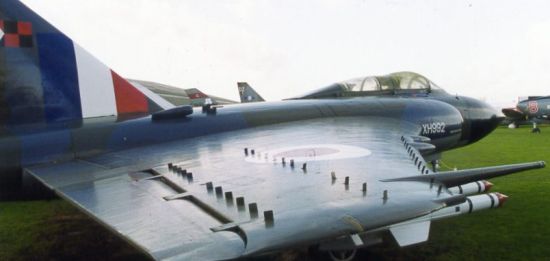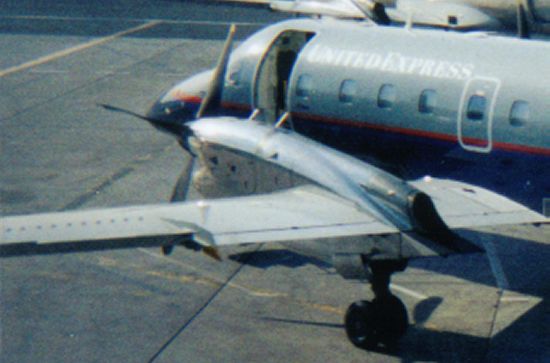Vortex Generators
What is a vortex generator?
- question from name withheld
If you've ever opened up the stopper in a sink full of water and watched the water swirl down the drain, you know
what a vortex is. Simply put, it is an energetic swirling mass of fluid. Vortices are quite common in
aerodynamics. Probably the most well-known and significant of these are the trailing
vortices that are seen coming off the tips of wings in flight. These vortices are not desirable because they
create a type of drag known as induced drag, or that drag induced by a surface generating lift (like a wing).
Aerodynamicists often spend considerable effort trying to reduce the adverse effects of such vortices. However,
vortices very similar to trailing vortices can also be used to produce beneficial effects, and one of the methods
used to create beneficial vortices is the vortex generator.
In previous questions, we have discussed the concept of flow separation. When an aircraft flies at high
angles of attack, the airflow over the wing can become detached, or it
stops following the shape of the wing. When this happens, the lift produced by the wing will suddenly and rapidly
decrease, and the wing is said to be stalled. When the flow separates from the wing, it usually means the
air is moving too slowly, or there isn't enough energy in the flow to keep it moving. Since vortices are
energetic, they can be used to put energy back into the flow to keep it moving in the desired direction. This is
what vortex generators are designed to do.
Vortex generators are simply small rectangular plates that jut above the wing surface. They look like tiny little
wings jutting up perpendicular to the wing itself. As air moves past them, vortices are created off the tips
of the generators just like the trailing vortices mentioned earlier. These vortices interact with the rest of the
air moving over the wing to speed it up and help reduce the possibility of separation. Vortex generators are
typically used in the following applications:
- Swept wings at transonic speed: Many early swept wings were found to suffer from
separation at transonic speeds because shocks formed on the
wing create an increasing pressure that slows the air suddenly and causes flow separation. The
Buccaneer attack plane and
Javelin fighter are good examples of such aircraft.

A Buccanner folding its wings, note the vortex generators near the leading edge
The Buccanner utilizes one set of generators along the leading edge of the outer portion of the
wing.

A Gloster Javelin showing the three sets of vortex generators located along the outer portion of the wing
Three sets of vortex generators are used along the Javelin's outer wing with one set located near
the leading edge, another just before the ailerons, and a third set in between. The generators on
both planes serve to break up the shocks formed at transonic speeds thereby delaying the effects of
separation. The generators located just ahead of the ailerons on the Javelin wing also help
improve the effectiveness of these control surfaces at low speed or high angle of attack, as
discussed in the next example.
- Ineffective control surfaces: The separation problem becomes even more significant since
control surfaces like flaps and ailerons are usually located along the trailing edge of a wing.
When the flow seperates from the wing, these control surfaces have little or no air flowing over
them and they become ineffective. Thus, not only will the aircraft lose lift when the wing stalls,
but the pilot may not be able to control the orientation of the aircraft. To correct this problem,
vortex generators are often placed just ahead of the control surfaces to create a faster flow of
air over the surfaces and increase their effectiveness. The following example shows vortex
generators placed ahead of the ailerons on an EMB-120 commuter airliner.

Vortex generators on the wing of an EMBRAER EMB-120
- Short-takeoff and landing aircraft: These aircraft generally must operate at low speeds
during takeoff and landing, so the flow speed over the wings tends to be low as well. Aircraft
like the C-17 Globemaster III transport use vortex
generators to create a higher-speed flow over the wings and control surfaces at these conditions
to improve performance and controllability. In the case of the C-17, the vortex generators are
located on the sides of the engine nacelles rather than on the wings but they still produce the
same beneficial effects.

Large vortex generator plates visible on the engine cowlings of a C-17
Vortex generators are not the only method used to delay wing stall. Wing fences, thick trailing edges, dogtooths
or sawtooths, drooped leading edges or slats, and leading-edge notches
produce similar effects. Each method has its drawbacks, most notably increased drag, and they are typically only
used as a last resort when re-designing the entire wing is not practical. For these reasons, they are sometimes
referred to as the "vacuum cleaners of the aerodynamicist" since they are used to clean up after previous mistakes.
- answer by Jeff Scott, 14 January 2001
Related Topics:
Read More Articles:







